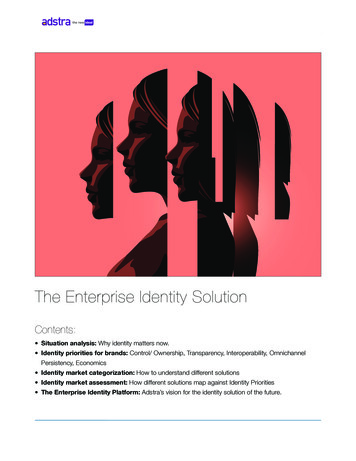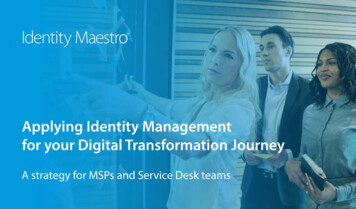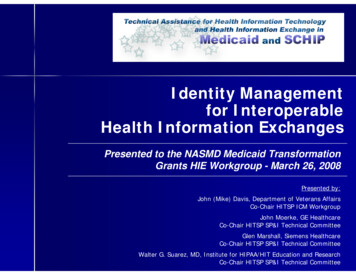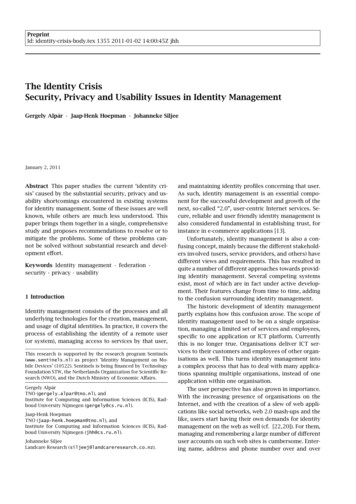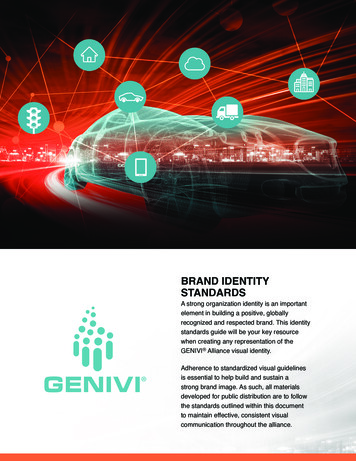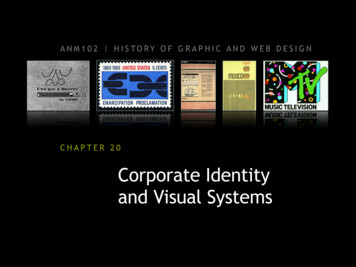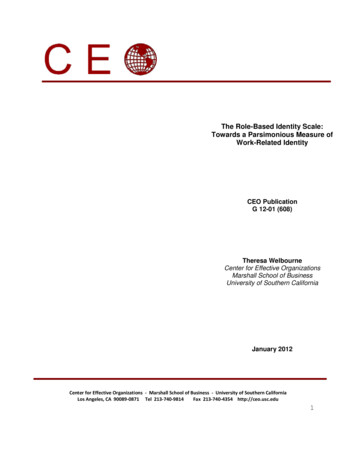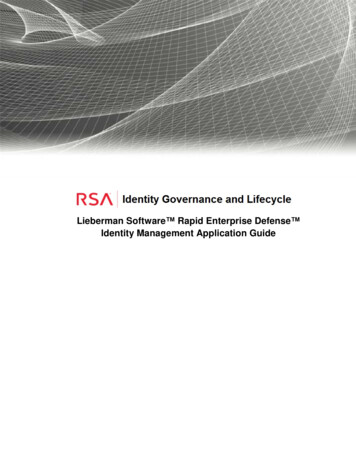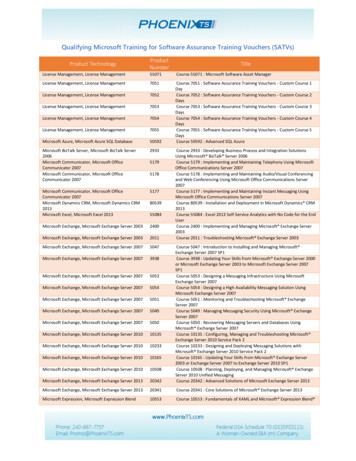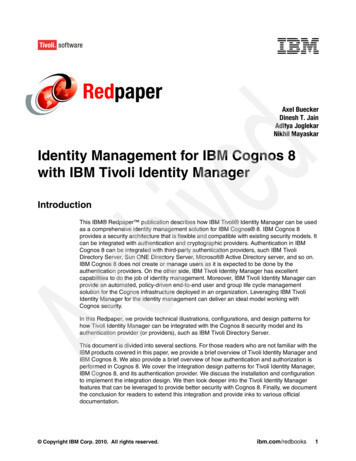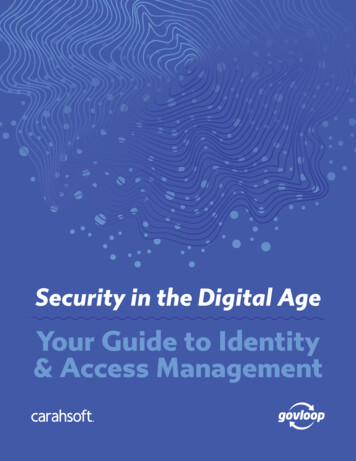
Transcription
Security in the Digital AgeYour Guide to Identity& Access Management
“How agencies conduct identity proofing,establish enterprise digital identities, andadopt sound processes for authenticationand access control significantly affects thesecurity and delivery of their services, aswell as individuals’ privacy.”-Office of Management and Budget ICAM Memo
Table of Contents4Executive Summary5What Does Identity and Access Management Meanfor Government?8Carahsoft Solutions Portfolio: Identity and AccessManagement10Identity and Access Management in the FederalGovernment Today13Mitigating Threats While Enabling the Citizen Experience15Q&A with David Temoshok, NIST IT Lab’s Senior PolicyAdviser for Applied Cybersecurity17Identity and Access Management in State and LocalGovernments Today21Identity is the New Perimeter22Q&A with Adam Zeimet, Branch Chief for ICAM at USDA25Thinking Like an Attacker to Protect Privileged Access26Breaking Down the Benefits of IAM28Q&A with Brandon Iske, ICAM Lead at DISA30Worksheet: Implementing an Identity Management System31ConclusionCarahsoft and GovLoop have partnered to provide resources around thelatest federal, state and local identity access management (IAM) initiativesand legislation. The goal is to guide government leaders and stakeholdersinterested in learning more about improving their cyber posture.Your Guide to Identity and Access Management3
Executive SummaryWhen cartoonist Peter Steiner illustrated and captioned a now iconic drawing about internetprivacy in 1993, he likely had little idea of its potential impact then — let alone nearly 25years later.The cartoon depicts two dogs. One is sitting at a desk in front of a computer and talking toanother dog seated on the floor. The computer-savvy dog’s words about internet anonymityare also used as the cartoon caption: “On the Internet, nobody knows you’re a dog.”It’s cute, right? Plus, who doesn’t love a funny cartoon dog with a sense of humor? But tofully understand the novelty of this illustrated message, consider that “surfing the internet”was a fairly new term in the early 1990s, and the general public was just getting its first tasteof a popular web browser.To say the online world has drastically changed since then is an understatement. We shop,bank, work, date, research and communicate online. If you were to take an inventory of thepersonal and professional accounts you have online that require you to verify your identity,you probably couldn’t list them all.In many ways, how we secure, manage and verify our digital identities have become asimportant — if not more important — than how we represent ourselves in person. Ourprivacy, security and sensitive assets are at stake and are more accessible to us, and tothose who wish to harm us. For government agencies, the ability to provide secure andseamless services to millions of people — think tax and public-safety systems — is on theline. It can be easy to get caught up in the excitement of all the possibilities that goingdigital can offer, but identity and access management (IAM) must be an integral part ofthat discussion.IAM is the security discipline that enables the right individual to accessthe right resource at the right time for the right reason. Ensuring itseffectiveness extends beyond the IT and cybersecurity teams. Everyoneplays a role, and they come from multiple offices, including finance, humanresources, legal, acquisition and physical security.And although IAM falls under the umbrella of security, functionality anduser experience are also central to securing digital identities. Employeesare sure to circumvent processes that are too cumbersome, which could harmindividuals and organizations.TheIAM marketis estimatedto reach 24.12 billionby 2025.We developed this guide in partnership with Carahsoft to study today’s IAM landscape.We examine what an effective strategy looks like, how to modernize capabilities andgovernment adoption, and use cases highlighting IAM shared solutions and services. Youwill also hear from IAM experts at the Agriculture Department (USDA), National Institute ofStandards and Technology (NIST), and the Defense Information Systems Agency (DISA).4A GovLoop Guide
What Does Identity and AccessManagement Mean for Government?In recent years, there has been an explosion ofonline service offerings from government agencies.Internally, employees can manage their pay andbenefits, request time off and analyze sensitivedata in the cloud. Government customers canaccess their health records via online portals, makeautomated payments and even avoid long lines at theDepartment of Motor Vehicles by going digital.To ensure the right people have access to theseresources at the right time — and for the rightreasons — IAM must be an integral part of thedesign, acquisition, operations and continuousmaintenance of these digital services.IAM also enables trust across organizational,operational, physical and network boundariesbecause, without it, confidence in the security ofthe service is lacking. Although IAM may not be asflashy as artificial intelligence (AI), robotic processautomation (RPA) and other hot tech, it is thefoundational layer that supports these and othercapabilities. An emphasis on IAM can also result inbetter customer experience through secure, userfriendly interactions, such as information sharing oraccessing an online service.In many ways, there has been a resurgence andrenewed focus on IAM as agencies move operationsoutside traditional office boundaries and look toaugment the workforce with tools that mimic humanbehaviors. And like humans, these technologies haveidentities that need to be verified. (We will discussthis more in our Q&A with USDA’s Adam Zeimet andin the section on the current federal landscape).Although this guide primarily focuses on thedigital side of IAM, physical security is also a realconcern. The ID cards that government employeesand contractors use to access computers are thesame cards that give them access to governmentfacilities. There have been discussions about securitybeyond these ID cards, but they are still the mainmethod that agencies use for identification andYour Guide to Identity and Access Managementauthentication. They were designed to work withtraditional computing devices, such as desktops andlaptops, and they can be clunky and cumbersomewhen trying to verify users on mobile devices.“However, as technology evolves, the governmentmust offer flexible solutions to meet changingtechnology needs and shift the focus from managingthe lifecycle of credentials to the lifecycle ofidentities,” according to a May 21, 2019, memo fromthe Office of Management and Budget (OMB) onthe government’s identity, credential and accessmanagement (ICAM) policy.We will explore those options, including new ways tohelp organizations authenticate mobile device userswho need secure access to information systems andapplications.Is it IAM, IdAM or ICAM?Whether you say IAM, IdAM or ICAM, theyare essentially the same thing. IAM or IdAM(identity and access management) used tobe more common, said Sarbari Gupta, aninformation security expert and CEO. Activelyinvolved in information security for more than20 years and co-author of several NIST SpecialPublications, Gupta said the “C” or credentialin ICAM became more commonly used in thefederal space because of former NASA ICAMSolutions Architect Tim Baldridge.Around 2011, NASA’s novel approach forusing government-issued personal identityverification (PIV) smart cards to connect toGoogle Apps for Government sparked a lotof buzz. That’s because the core method youuse to prove who you are is the cornerstoneof IAM’s strength, Gupta said. You can’t talkabout IAM without talking about credentialing,such as PIV and common access cards (CAC).
KEYWORDS TO KNOWIdentityFederal enterprise (enterprise identity)The unique representation of a subject, such as aperson, device, non-person entity or automatedtechnology, that is engaged in a transaction involvingat least one federal subject or a federal resource,such as federal information, an information system,or a federal facility or secured area.The unique representation of an employee, acontractor, an enterprise user such as a mission orbusiness partner, a device, or a technology that afederal agency manages to achieve its mission andbusiness objectives.Source: Whitehouse.govSource: Whitehouse.govAuthorizationIdentity proofingA process in which an applicant provides evidenceto a credential service provider reliably identifyingthemselves, thereby allowing the provider to assertthat identity at a useful identity assurance level.Generally, there are two options for identity proofing:in-person and remote (performed over an online,networked session).Source: NISTPublic identityThe unique representation of a subject that afederal agency interacts with, but does not directlymanage, in order to achieve its mission and businessobjectives. Public identity may also refer to amechanism of trust used to render services to theAmerican public.Source: Whitehouse.govDigital identityThe unique representation of a subject engaged inan online transaction. A digital identity is alwaysunique in the context of a digital service but does notnecessarily need to uniquely identify the subject in allcontexts. In other words, accessing a digital servicemay not mean that the subject’s real-life identity isknown. Identity proofing establishes that a subject iswho they claim to be.Source: NISTThe process of granting or denying a user accessto system resources once the user has beenauthenticated. The amount of information and theamount of services the user has access to dependson the user’s authorization level.Source: Identity Management InstituteAccountingThe process of keeping track of a user’s activitywhile accessing the system resources, including theamount of time spent in the network, the servicesaccessed while there and the amount of datatransferred during the session.Source: Identity Management InstituteAuthenticationProves a user’s identity. It is based on the ideathat each user will have unique information thatsets him or her apart from other users to provideproof of identity. There are primarily four typesof authentication methods and they use staticpasswords that remain active until they are changedor expired; one-time passwords,such as codes deliveredthorough SMS texts orClose to 90% oftokens used for eachbusinesseswill useaccess session;biometric authenticationdigital certificates;by 2020. Today, 57% ofand biometricorganizations use fingerprintcredentials.scanning as large companiesSource: IdentityManagement Institute6attempt to get rid of theneed for passwords.A GovLoop Guide
CREATE & MAINTAIN AN IDENTITYSource: idmanagement.govWhen an employee or contractor onboards at an agency, their identityinformation is collected and stored to act as their digital proxy in ITsystems. This information is stored within an identity record, which maybe modified or deleted as needed.Once this digital identity record is established, it may be pushed to othersystems from an authoritative source and provisioned access permissions.Employee sourceDatarepositoryChange to theidentity record1. INFORMATION POPULATEDPersonnel information is populated into theauthoritative source. Sources for this informationcould include onboarding documents or HR systems.2. NEW IDENTITY RECORD CREATEDThe authoritative source sends the information tothe system’s data repository.3A. MODIFY RECORD3B-1. MODIFY RECORDMANUALThe administrator receives a change requestand updates personnel information in theauthoritative source.The individual uses an agency application toupdate their personal information.3B-2. MODIFY RECORD3C. DELETE RECORDThe administrator deletes the identity recordwithin the authoritative source when notifiedthat deletion is required.SELF-SERVICESELF-SERVICEThe agency application updates theindividual’s identity record within theauthoritative source.X4. DATA REPOSITORY UPDATEDThe authoritative source updates the availableidentity information to the data repository.Your Guide to Identity and Access Management7
Carahsoft Solutions PortfolioIdentity and Access ManagementIdentity and Access Management have become crucial to organizations’ security, helping themstay secure and compliant at the same time and never compromising one for the other. Carahsoftrepresents best-of-breed solutions, providing agencies with a multi-faceted approach involvingsecurity, governance, automation and controls, and federated identity based on virtualization.See how agencies are benefiting from these solutions in the use cases featured below, and learnmore at carahsoft.com/identity.Carahsoft’s Identity and Access Management solutions are available through its reseller partners on a variety of contractsincluding Carahsoft’s GSA Schedule 70, SEWP V, NASPO ValuePoint, National IPA, and numerous state and local contracts.CyberArk: Managing Privileged Accounts & CredentialsA federal government agency was struggling with balancingsecurity with productivity as well as rampant passwordreuse across multiple accounts. They found that their ITadmins had more privileges than they truly needed, andthere were too many endpoints with local administratorprivileges. The agency knew they needed to be betterprepared for an audit, and they were also driven by anexecutive mandate.The agency wanted a solution that could provide forprivileged access security to limit the exposure ofprivileged credentials; enforce strong passwords, storethem in an encrypted vault, and rotate them; and secureinfrastructure and assets in the cloud.They turned to CyberArk to protect their highest-valueinformation assets, infrastructure and applications,8deploying CyberArk to secure privileged credentials in avault, rotate credentials based on policies, and secure androtate shared service accounts.The agency also plans on managing the following types ofprivileged accounts, credentials and secrets with CyberArkin the next 12 to 18 months: Domain admin accounts;Microsoft Windows admin accounts; NIX admin accounts(UNIX and Linux); and database or application adminaccounts.Since adopting CyberArk, the agency reports that they arenow more secure, that the time and cost of audit reportinghas been reduced, and that the time required to manageand maintain privileged account and credential security hasbeen reduced significantly.A GovLoop Guide
Okta: Improving Security, Reliability, Scalability & User ExperienceOkta helps governments around the world serve citizensbetter with increased security and reduced cost. Lately,they’ve been noticing a trend in the government agenciesthey work with.“We are seeing agencies that hope to modernize citizenand public-facing properties,” said Ted Girard, VicePresident Public Sector, Okta. The Centers for Medicareand Medicaid Services (CMS) selected Okta to transitionthe agency to a modern and flexible identity architectureand to build the Quality Payment Program (QPP) interface,centered around shifting U.S. healthcare to a value-basedpayment model and away from traditional fee-for-service.“They chose Okta’s Identity Cloud to improve the security,reliability, scalability and user experience for its QPP webpresence,” Girard explained. The QPP is the external facingsystem that interacts with all healthcare professionals whoprovide Medicare and Medicaid services.“CMS and their users had such a good experience after theportal was modernized, that they have now brought us in towork on internal-facing portals for them,” Girard said.The State Department’s Directorate of Defense TradeControls had a similar experience when they modernizeda paper-based system that interfaces with aerospace anddefense contractors. They chose Okta as the IAM solutionfor their custom applications.“In short, we’ve noticed that the first things gettingmodernized are public-facing properties, and then thatpositive experience leads an agency to want to do this fortheir employees and contractors too.”Radiant Logic: Building a Modern, Flexible Identity ArchitectureThe Department of Homeland Security (DHS) consistsof numerous different programs and agencies such asFEMA, TSA, and the US Borders and Protection Agencies.Its employees needed fast and secure access to theDHS network for email, facility control, training andattendance systems. However, identity and attribute datawas fragmented across multiple data repositories, andincorporating change required manual, repeated steps. Inaddition, every internal system used a unique collectionof the user’s digital identity and credential data. Keepinga high degree of access control over this wide array ofapplication types and points of entry presented a constantchallenge to the DHS’s IT personnel.To help aggregate all identities for proper authenticationand authorization, DHS set up the Trusted IdentityExchange (TIE), enabling and managing the digital flow ofidentity, credential, and access-management data for DHSemployees and contractors. TIE is powered by RadiantOne,a federated identity and directory service based onvirtualization. It establishes connections to variousinternal authoritative data sources and provides a secure,digital interface to other DHS consuming applications —essentially a ‘one-stop-shop’ of trusted identity information.This cross-agency federal identity infrastructure canproduce the specific composite views required by eachapplication. RadiantOne is now a key enabler for manyimportant DHS initiatives, including the DHS DataFramework, Personal Identity Verification (PIV) Smart Cardusage, Single Sign-On (SSO) and fine-grained, attributebased authorization.SailPoint: Providing Identity Access Management for Custom ApplicationsOver the past year, Karen Wrege, CIO, Department of State’sDirectorate of Defense Trade Controls (DDTC), led a major“cloud first” IT modernization effort to improve efficiency andsecurity for DDTC employees and external customers.Tasked with modernizing DDTC’s IT platform, Wrege’s teamlaunched the Defense Export Control and ComplianceSystem (DECCS) in February 2019. This online portalprovides industry with consolidated access to neededDDTC applications, and significantly streamlinesoperations. It also gives thousands of external users accessto a system housing millions of Controlled UnclassifiedInformation documents.After attempting a custom solution, the team explored aCOTS IAM solution, looking for one that would providesecurity for users within and beyond their network,Your Guide to Identity and Access Managementintegrate custom and SaaS applications (new existingtechnology), and could be procured quickly. Based onmeeting the wish list objectives and other governmentsuccessful government uses cases, Wrege selected Oktaas the IAM solution for their custom applications andServiceNow implementation.DDTC’s new IAM strategy has reduced customer wait timesand improved the customer experience. After a successfulimplementation, the Department of State recently assessedIAM requirements to satisfy the need for on-premisesIAM for thousands of domestic employees — and an evengreater number of personnel serving overseas. Based onthe assessment, the team identified criteria, ultimatelyselecting Radiant Logic, SailPoint, CyberArk and Okta tosupport all users internal and external.9
Identity and Access Management inthe Federal Government TodayCURRENT LANDSCAPEIAM is not just about doing security to comply withgovernment requirements. Instead, it’s a meansto ensure the consistency and trustworthiness ofgovernment services, especially as digital optionsexpand.This expansion means that office walls no longerdefine agencies’ perimeters because employeesare increasingly accessing resources and dataremotely from various devices. In light of these andother changes, OMB issued updates to the federalgovernment’s ICAM policy in May 2019. Among otherthings, the policy calls on agencies to take a riskmanagement approach to identity management andalign with NIST guidelines.Gone are the days when simply adhering to achecklist of security mandates was enough to defendagainst online impersonators, fraudulent claims andother attacks. Agencies must understand the uniquerisks they face and use that information to drivewhat technologies and mitigation strategies canreduce them, according to NIST Special Publication800-63 revision 3, which establishes digital identityguidelines for federal agencies.The policy update also calls on agencies to shift frommanaging who has access inside and outsidetheir perimeter to using identity as the foundationfor managing risks resulting from attempts to accessfederal resources. Having stronger authenticationmethods in place requires malicious actors to havebetter capabilities and expend greater resourcesto successfully subvert the authentication process,according to NIST.Following the massive Office of PersonnelManagement (OPM) breach in 2015, the Obamaadministration launched a 30-day cybersecuritysprint to assess and improve the health of federal IT.That decision set into motion an accelerated effort toensure all users, especially privileged account holderssuch as system administrators, use PIV cards toaccess federal networks and systems.Those efforts are still being felt today, accordingto Sabari Gupta, an IAM expert. Even if agenciesare not fully compliant with the federal directiverequiring PIV cards, they areprioritizing the use ofthese credentials forFederalaccount holdersagencieswho couldenforce the use ofdo the mostPIV cards among 93 percentharm to theof their privileged users, ororganization.those who have access tolarge amounts of sensitiveagency and citizendata.93%
WHY IS IAM ESPECIALLY IMPORTANT NOW?The number of digital transactions between thepublic and government agencies is rapidly increasing.Citizens can skip in-person visits, and with a fewclicks or swipes, they can file taxes, apply for foodassistance and renew a license.Although the rapid expansion of digital services hasgiven the federal government faster, more reliableoperations and connections with the public, it hasalso shed light on IAM’s critical role in providing aseamless digital experience.IAM is particularly important now as technologiessuch as cloud mature and older IT systems becomeobsolete. “A new set of challenges has emerged,because information about individuals has becomemore widely available through social media andbreaches of personally identifiable information (PII),”according to the OMB memo on ICAM. “Identitymanagement has become even more critical to thefederal government’s successful delivery of missionand business promises to the American public.”Agencies must adopt identity validation solutionsthat enhance privacy and mitigate negative impactson the delivery of digitalservices and maintenanceof online trust.64%HOW DOES IAM SUPPORT IT MODERNIZATIONAND OTHER EFFORTS?As noted earlier in the guide, IAM underpins manygovernment efforts, including conducting backgroundinvestigations, managing access to federal IT assetson-premise and in the cloud, and deploying emergingtechnologies such as RPA.IAM allows for secure and frictionless informationsharing with the right people at the right time, andthis is especially important as more governmentservices move to cloud-based models. To support theincrease of mobile technologies, OMB has made clearthat agencies should use derived credentials, whichprovide strong authentication for mobile devices.With the rise of automated tools that can take onidentities of their own, agencies must be capable ofmanaging digital identities for RPA tools and AI.Your Guide to Identity and Access Managementof U.S. federal ITleaders view identitymanagement as criticalto cybersecurity.For example, softwarebots can run unattendedand work round-the-clock, meaninga person does not have to physically oversee all thework a bot is doing. This is great for productivity, butautonomous bots can raise security concerns.That’s why OMB requires agencies to ensurethat digital identities for automated tools aredistinguishable, auditable and consistently managedacross the agency. “This includes establishingmechanisms to bind, update, revoke and destroycredentials for the device or automated technology,”according to the memo.11
Modernizefasterwith OktaAgencies need innovative solutions tomodernize infrastructures, increase security andreduce cost while serving citizens better.Identity Management is the hidden acceleratorfor secure digital transformation.Okta provides FedRAMP compliant cloudidentity solutions that help governmentagencies do more faster.www.okta.com/solutions/government10 A Govloop Guide
INDUSTRY SPOTLIGHTMitigating Threats While Enablingthe Citizen ExperienceAn interview with Ted Girard, Vice President of Public Sector, OktaAgencies today are looking to better reach citizens andimprove internal processes, all while staying ahead ofmodern threats.management (ICAM) policy, encouraging the use of moreflexible solutions, supporting pilots for new authenticatorsand requiring agencies to create an ICAM team.But as agencies focus on these efforts, they must bemindful of mitigating dangers to their data.The memo notes: “While hardening the perimeter isimportant, agencies must shift from simply managingaccess inside and outside of the perimeter to using identityas the underpinning for managing the risk posed byattempts to access federal resources made by users andinformation systems.”Credential-based attacks – such as phishing, passwordspraying, brute force and more – are common vectors thatcan be mitigated with strong multifactor authentication,built into the workforce/IT experience and also constituentfacing programs.Whether your agency is building a new citizen-facing portalor unifying a constellation of existing services, there areways to prevent these credential-based attacks and makeweb and mobile access secure, compliant and frictionless.“Today, people are accessing more resources from morelocations than ever before, changing the dynamic awayfrom the previous ‘castle-and-moat’ or perimeter-styleapproach to security and instead centering controls aroundthe only commonality in today’s environment: people – andtheir identities,” said Ted Girard, Vice President of PublicSector at Okta.“By tackling security from a zero trust lens – and we’veheard from a number of customers that identity is oftenwhere they start on their zero trust journey – they’ll bebetter equipped to mitigate today’s threat actors, especiallythose employing the common credential-based attacks.”“The memo aligns really well with how Okta sees identity’srole evolving both from a management and security/privacyperspective in government agencies,” Girard explained.“Okta can play a role in supporting major IT modernizationprojects, as well as in improving security for agencies.Our cloud-based, industry-leading identity and accessmanagement platform comes with all of the tools you needto manage a complex user base at scale.”IT and security leaders recognize the need to adopt new,often cloud-based technologies to better support andsecure their workforces and constituents, but they’realso faced with decades’ worth of legacy technologies,regulations and processes that stifle adoption and growth.“Okta can help make the transition easier and moresecure, which is why today dozens of agencies useOkta to consolidate disparate systems, securely adoptcloud services and find new ways to better reach theirconstituents,” Girard concluded.To this end, the Office of Management and Budget (OMB)recently updated its federal identity, credentials and accessTAKEAWAY:“Today, people are accessing more resourcesfrom more locations than ever before, changingthe dynamic away from the previous ‘castle-andmoat’ or perimeter-style approach to securityand instead centering controls around the onlycommonality in today’s environment: people —and their identities.”Your Guide to Identity and Access ManagementAgencies must shiftfrom simply managingaccess inside and outsideof the perimeter to usingidentity as the basis fortheir security posture.13
IAM FEDERAL POLICIES,GUIDANCE, STANDARDSFEDERAL LAWS THATIMPACT IAMOMB’s “Enabling Mission Delivery through ImprovedIdentity, Credential, and Access Management” memoupdates the federal ICAM policy. (May 2019)The Privacy Act of 1974 covers the privacy ofindividual federal records, including systems thatrequire the retrieval of records based on PII such asSocial Security numbers.NIST Special Publication 800-63 revision 3 providestechnical requirements for federal agenciesimplementing digital identity services. (June 2017)The White House’s National Strategy for TrustedIdentities in Cyberspace enhances the securityand privacy associated with online transactions.(April 2011)The Federal Identity, Credential, and AccessManagement Roadmap and ImplementationGuidance provides a common framework for rollingout ICAM programs across government. It alsoincludes a variety of use cases for managing internaland external identities. (December 2011)HSPD-12: Policy for a Common IdentificationStandard for Federal Employees and Contractorsis a strategic initiative intended to enhancesecurity, increase government efficiency, reduceidentity fraud and protect personal privacy. Itrequires the development and implementation of agovernmentwide standard for secure and reliableforms of identification for federal employees andcontractors. (August 2004)To review other federal policies and standards thatimpact and shape the implementation of ICAMprograms and systems, visit arch.idmanagement.gov/standards.14The Health Insurance Portability and AccountabilityAct protects personally identifiable healthinformation by mandating privacy compliancewith federal guidelines. IAM is crucial to the use offederated identities, single sign-on (which allows foraccess to multiple, in
Source: Identity Management Institute Accounting The process of keeping track of a user's activity while accessing the system resources, including the amount of time spent in the network, the services accessed while there and the amount of data transferred during the session. Source: Identity Management Institute Authentication
